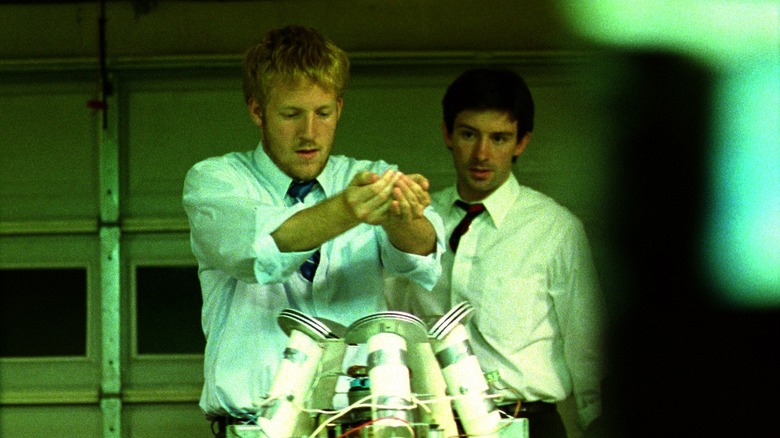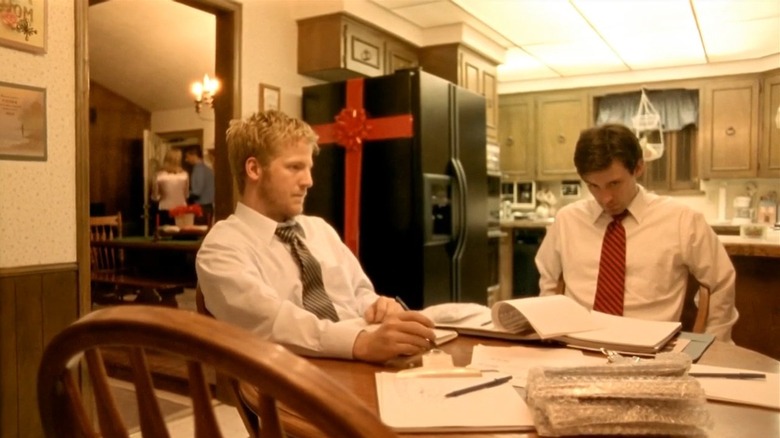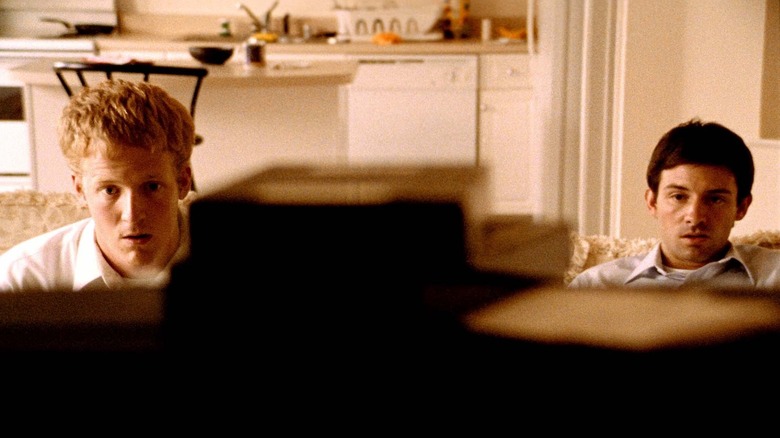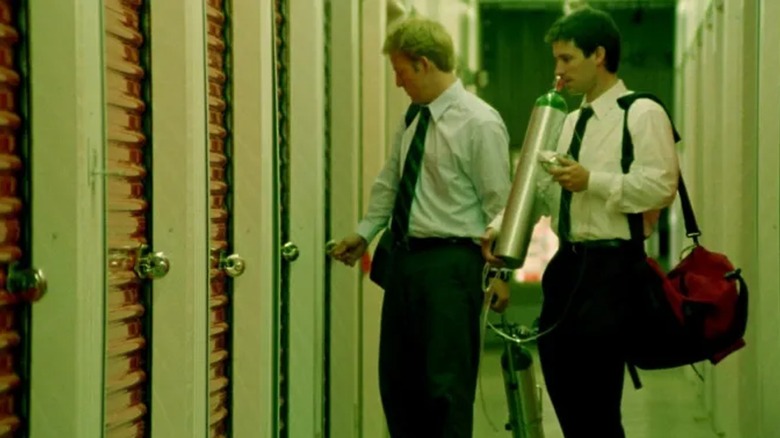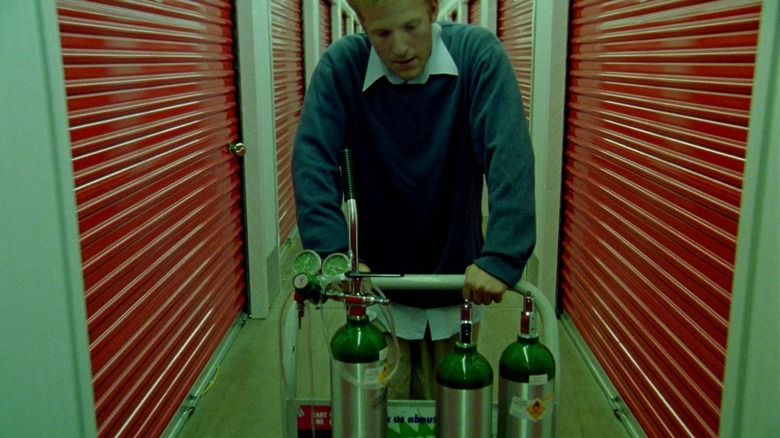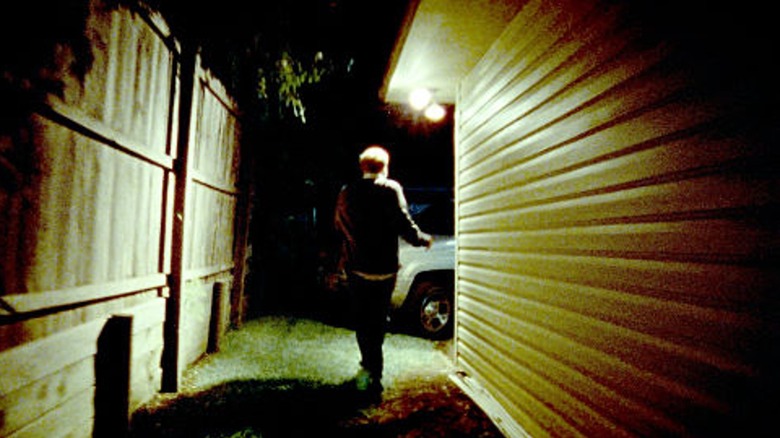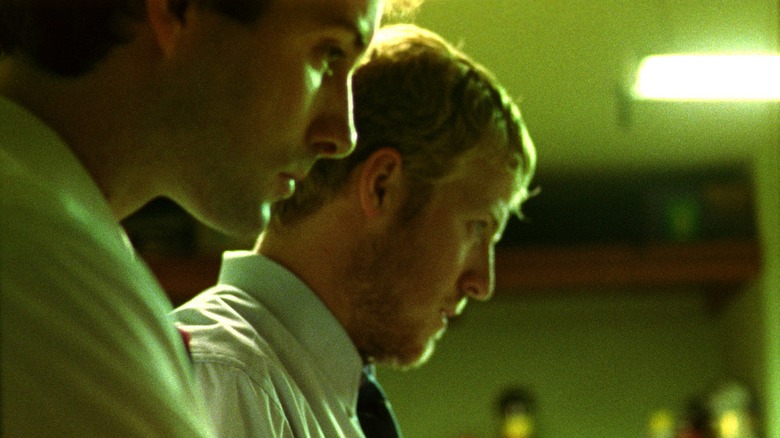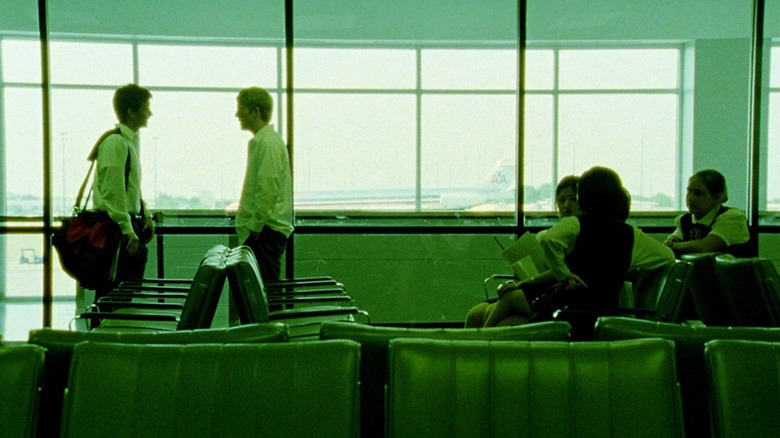The Most Confusing Moments In Primer Explained
This post contains spoilers for "Primer."
It is tempting to describe "Primer" as a time travel film — which it very much is — but the sheer headiness of the subject matter morphs it into something undefinable and elusive, eclipsing the metaphor of a puzzle box by the time the credits roll. Crafted with a shoestring budget of roughly $7,000, Shane Carruth's debut feature demands a certain sense of discipline and meticulous attention to detail, where seemingly innocuous dialogue or subtle character expressions often prove crucial to unraveling its wildly complicated plot. To call "Primer" confusing is an understatement: it is a film that absolutely requires repeat viewings simply to be understood, but engaging intimately with it does not guarantee comprehension of every facet.
Although Carruth peppers enough clues and red herrings to help us arrive at a sound conclusion, "Primer" does not encourage the tying up of every loose end, or offer objective answers for every paradoxical query. Abe (David Sullivan) and Aaron (Carruth) seem to follow a linear trajectory until they stumble upon an anomaly in one of their projects, but this established timeline is later usurped with the formation of newer ones that feature different versions of the two characters. "Primer" does not believe in audience handholding and essentially relies on viewers to piece the story together, leading to divisive interpretations of time travel paradoxes. These concepts do not benefit from objective scrutiny but are driven by deeply personal character impulses to control and warp space-time and causality.
With unreliable narration and deliberate subversion thrown into the mix, "Primer" emerges as a discombobulating salad of events that are hard to digest or reconcile. Here are some of the most confusing, oblique moments in "Primer," explained.
What were Aaron and Abe initially experimenting in Primer?
To start with comparatively simple events, Aaron, Abe, and their friends Philip (Anand Upadhyaya) and Robert (Casey Gooden) routinely get together in Aaron's garage to work on scientific projects that they hope to patent and sell for monetary purposes. Each person posits an idea in turns, and the others help him realize the project using the most cost-effective parts, but these efforts do not bear fruit even after multiple tries. The one time they do succeed backfires, as their boss, Joseph Platts, snatches up the patent and makes a ton of money after stealing their idea.
The latest attempt is Robert's idea of building a device that can reduce the mass of an object in theory, promptly assembled by Abe and Aaron, who yank out parts from everyday devices like their fridge or car to cobble together something that can facilitate this experiment. Aaron takes the lead to adjust the box as per his whims to simulate a situation where the object inside the device (or box) is exempt from the effects of gravity, hence causing it to weigh "less." This works and the two tweak and tinker with it (by dropping punched holes into the superconductive field, where the objects float due to reduced mass), and soon realize that the device has massive market potential. Deciding to keep their discoveries a secret from their friends, the two consider publicly announcing it, but ultimately decide to understand the potential of the device better before making any moves.
Abe and Aaron eventually use this rudimentary device to create bigger boxes that facilitate time travel, but this discovery is accidental, which brings us to how this idea becomes a possibility for the two.
How do Aaron and Abe accidentally invent a time travel machine?
The object used in the weight reduction device is a weeble, and several experiments lead to a common fungus growing on it, but the amount that should account for five days' worth of fungus growth instead seems like five or six years. Abe deduces that a space-time anomaly is responsible for this, opening the gates for potential time travel speculations. However, this theory is solidified after a specific experiment, where the weeble is placed inside the box and observed as it to travels from point A to B within a fixed timeframe, with the electromagnetic field ebbing and flowing while determining the trajectory of the weeble.
In simplest terms, the weeble travels from A to B and back again in a set amount of trips depending on the entry point, where inserting the weeble through A generates an odd amount of trips between the points, while B generates an even number, like a trip worth 1,334 minutes. Abe and Aaron control the time that the weeble spends inside the box to monitor its parabolic movements and eventual exit and conclude that the weeble accumulates time from its point of view as the device allows it to move backward in time. As the weeble isn't sentient, it is rather limited in its scope of exhibiting awareness of time travel, prompting the two friends to experiment with a robot with some amount of base intelligence.
However, things take a drastic turn after Abe approaches Aaron on a park bench on Monday, declaring that they are about to witness something that would forever alter the trajectory of their lives. Turns out, Abe has already moved on from his prototype and built a functioning time travel box placed inside a self-storage facility.
How does the actual time travel device in Primer work?
Some glaring queries about the machine(s) are never answered, so we will have to work with what we know. After Abe explains how his box (let's call it Box 1) works, Aaron builds his own box (Box 2) to travel back in time together while replicating everything Abe did to achieve it. When the two first start traveling back in time, they intend to buy more time for themselves as their doubles carry on the tasks stipulated for them, allowing causality to flow without multiple versions of the same person existing within the same timeline. To ensure this, the two must follow some rules related to cause and effect as this process is effectively repeated (until it is not) for at least four days.
The most rudimentary flow of their actions, without any anomalies or aberrations is this: both Abe and Aaron set a 15-minute timer on their respective boxes and turn it on, leaving the area and isolating themselves in a hotel to ensure minimum causal interference from the outside world. This means no cell phones or pagers, or anything that could accidentally lead them to people they know — during this time, the two check stock prices and make note of it. After six hours pass, they go back to their boxes and travel back in time by six hours. The interior of the boxes is akin to sensory deprivation tanks that often induce dreams, explaining their shared, serendipitous dream of calming ocean waves.
As their doubles will mimic their actions, they must allow this to happen when new personal timelines are created. So now, Aaron and Abe must avoid their doubles at all costs to prevent the existence of multiple Aarons and Abes in the same timeline.
Was Abe truly the first one to initiate the causal loops?
Yes and no. Although Abe is the first to build both Box 1 and a failsafe machine (which we will call Failsafe 1) according to linear time and travel back without repercussions, the ability to go back and change things alters this event with lasting consequences. On Wednesday, Aaron realizes that Abe has two storage rooms under his name, leading to the discovery of Failsafe 1, which prompts Aaron to fold up Box 2 and travel through the failsafe further back in time, allowing him to record conversations as and when they happen since Monday (the day everything started). With this solo act of time travel, a new timeline for Aaron is created.
After traveling back to Monday, Aaron uses Box 2 as his own failsafe, which we will call Failsafe 2, which he moves to another storage unit in the facility. He resets Abe's Failsafe 1 and delays it by 30 minutes, closing his loop in the process. This creates a horrible temporal anomaly: there are now two Aarons in the same timeline, and the one who traveled all the way back to Monday is now Aaron-2, while the original Aaron (Aaron Prime, for simplicity's sake), is unaware of this anomaly and is still sleeping in his room. Aaron-2 (identifiable by his red hoodie) injects a sedative into Aaron Prime's breakfast milk, drags his drugged body to the family attic, and assumes his identity.
A brief, seemingly unimportant conversation makes this clear, where Aaron's wife, Kara (Carrie Crawford), complains about noises from the attic, but hindsight makes it clear that it was Aaron Prime trying to get out, while Aaron-2 plays it off as rats scampering about in the space.
What is the deal with Robert's birthday party?
Although Abe does not tell Aaron about his failsafe, there seem to be no nefarious reasons behind this, except for it to be a backup machine in case the flow of causality is broken. Aaron, however, does everything to make it impossible for Abe to travel back before he does (as evidenced by the deliberate half-hour delay in the failsafe reset) and interferes in events to change outcomes. The event in question is Robert's birthday party on Monday night, where Abe's girlfriend, Rachel, is present. In the original timeline, Rachel's ex disrupts the party by pulling out a gun, but does not fire or harm anyone — however, with Aaron-2 traveling all the way back, he interferes by disarming the dude and becoming somewhat of a hero.
This is news to Abe as he was not present at the party, and he scolds his friend for endangering his life and that of his family, although he is unaware that this is an altered event due to Aaron-2's interference with the past. Abe is still unaware of Aaron's shenanigans and only learns about them after it is too late.
Does Aaron-2 care about breaking causality? Not really, as he seems obsessed with the idea of seeming like a hero, and presents it as a noble attempt to make sure that Rachel's ex is behind bars, even if it means disrupting temporal integrity. This callousness spills over to one careless act that unravels everything: Aaron-2 accidentally brings his phone with him to the isolated hotel on Thursday and answers it. Abe warns him not to take the phone with him after they travel back (to prevent a grave paradox), but he does, breaking symmetry and changing history again.
How does Thomas Granger fall into a coma?
Before we dive into this, let's talk about the repercussions of Aaron's cellphone mishap: because symmetry is broken, this creates another set of Abe and Aaron in the same timeline, where it is unclear whether their doubles will mimic the paths set for them. This anomaly might have caused one of the doubles to contact Thomas Granger, the person financing the time travel boxes, who is also Rachel's father. If we are to follow the logic of the timelines, Granger must have entered one of the boxes on Friday to travel back to Thursday to prevent the anomaly, which explains how Abe and Aaron-2 see an altered version of him (with days of beard growth) at around 2 am on the same day. However, Granger inexplicably falls into a coma once Aaron-2 comes close to him during a chase.
Devastated by what has happened, Abe decides to use Failsafe 1 to travel back to Monday to prevent everything from occurring. On arriving at the new timeline, he now becomes Abe-2 and proceeds to drug Abe Prime (who is at home) and locks him in a closet after drugging him. On reaching the bench where he first persuaded Aaron, Abe-2 collapses due to the exhaustion of traveling so far back and the shock of subduing his double, while Aaron reveals himself to be Aaron-3, as Aaron-2 also traveled back to Monday at the same time as Abe did. However, due to the 30-minute reset delay in Abe's failsafe, Aaron-3 arrived earlier, staying one step ahead while listening to the recorded conversations of previous timelines to ensure events are altered without causality being broken.
Thus begins the temporal tyranny of Aaron-3, and the effects of time travel without causal consideration.
Why do Abe-2 and Aaron-3 agree to cooperate?
By now, every secret is out in the open, as a confrontation between Abe-2 and Aaron 3 brings both parties up to speed. They discuss the price of traveling so far back, especially for Aaron-3, who is most exposed to the boxes, explaining why his ears begin to bleed. Abe feels guilty about Granger's condition, which was caused by Aaron-3's anomalous presence (being the person who has traveled back the most in time). As temporal symmetry has been broken, the alteration of history at the birthday party by Aaron-2 in his timeline is null, leaving it up to Abe-2 and Aaron-3 to prevent her ex from endangering Rachel and making sure he ends up in jail.
With this common goal, the two work together at the party to "reverse engineer" a perfect opportunity to de-escalate the situation and ensure that the dude is behind bars. They succeed, but it is never specified how many tries it takes for them to do so, as Abe-2 has to factor in his presence now (as he was absent in the original timeline) and Aaron-3 has to repeat conversations while changing things enough to usher the desired outcome. Once they succeed, Abe-2 and Aaron-3 have no reason to cooperate, as their bond has been irrevocably broken — while Abe wants to go back in time and prevent everything, Aaron wants to start a new life.
In the end, the two decide to part ways, where Aaron-3 decides to leave by stealing Aaron Prime's passport (who, by the way, manages to get out of the attic), while Abe-2 decides to stay back and secretly monitor everyone including Kara and her daughter, to make sure nothing bad happens (while Abe Prime also escapes his confines).
Who is the film's narrator and whom does he address?
When Aaron-3 initiates the new timeline on Monday, he goes home to tackle Aaron-2 and drug him, but the latter knocks him over. The two talk it out, and on learning Aaron-3's plan, Aaron-2 agrees to leave town. By the end, it is clear that Aaron-2 is the one leaving messages for either Abe or his own double through voicemail — however, as only Aaron Prime and Abe Prime are unaware of the full picture, it must be addressed to either one of them. Aaron-2 is also seen instructing workers who are building something, which is presumably a much bigger version of the boxes, leaving his intentions and the fragility of the causal loops up in the air.
The question of why Aaron is so obsessed with changing the outcome of the party seems unclear, as the original event does not end in pain or tragedy for anyone involved. The alterations only lead to a person being sent behind bars and Aaron being hailed as a hero, which could very well be a motivator for such extreme lengths. Moreover, both Abe and Aaron fundamentally misuse their ability to exist outside of time — instead of immersing themselves in these beautiful, rare moments that no one else has access to, they meddle needlessly with time's flow and mess things up beyond repair.
Every version of Abe and Aaron has lost something precious to them, be it their loved ones, their place in the world, or an essential part of their selves. "Primer" might dazzle us with its twisty time travel mechanics and casual loops, but its heart is the rot that grips a pure friendship, which could have been nourished and sustained until the very end. Well, maybe in some other timeline.
